Smartphone Audio Testing - HTC One M8 and Samsung Galaxy S5
by Chris Heinonen on June 2, 2014 8:00 PM EST- Posted in
- Smartphones
- Mobile
- Testing
- Audio Precision
HTC One M8 Audio Testing
Looking at the numbers for the HTC One M8 there are a few things that stand out. The first is the output power of around 1.2 Vrms for all loads. This is a lot of power for a smartphone and should be able to drive almost any set of headphones you would use with it. There is more distortion on the 15 Ohm load but as there are 95 mW at max volume, you should be able to step the volume down a bit and reduce the THD+N.
We also see that crosstalk gets better as we have an easier load to drive. The lower (more negative) the crosstalk is, the less noise is leaking from one channel into the other. This is also the test most subject to error when using the USB automation of the phones. On the HTC One M8, USB testing results in a crosstalk level of -0.01 dB. If you are using your HTC One M8 for music you are best to not have it connected over USB while listening.
| 15 Ohm | 33 Ohm | 150 Ohm | 330 Ohm | |
| Dynamic Range | 91.791 dB | 92.074 dB | 91.690 dB | 92.008 dB |
| THD+N | 0.3365% | 0.0152% | 0.0103% | 0.0101% |
| Crosstalk (L) | -58.032 dB | -64.780 dB | -77.688 dB | -83.656 dB |
| Crosstalk (R) | -57.950 dB | -64.329 dB | -77.194 dB | -83.240 dB |
| Output Power | 95.55 mW | 47.63 mW | 11.14 mW | 5.116 mW |
| Output Voltage | 1.197 Vrms | 1.254 Vrms | 1.293 vRMS | 1.299 Vrms |
| Relative Level (20Hz - 20kHz) | ±0.664 dB | ±0.664 dB | ±0.665 dB | ±0.665 dB |
For some of the other results, I am going to pull in some charts that help to explain it better.
Relative level shows it is flat until the 20 kHz tone. Since most people can’t even hear this, the fall off there isn’t a large deal. The fall-off at 20Hz, which most earbuds cannot produce to a reasonable level, is much more slight and not audible. Unless you are playing back music for your puppy with the HTC One M8, this result is fine but it could be better.
THD+N is below 0.03% until just after 2 kHz when it begins a slow rise up past 0.2% at 20 kHz. This winds up being a good number but I am unsure what causes the rise in THD+N as the frequency increases.
The FFT spectrum for the 997 Hz test tone shows all artifacts below -80dB compared to the fundamental. The second and third harmonics are the largest, and those drop off by -10dB by the 4th and 5th.
This graph compares the frequency response to the BoomSound feature to having it disabled. As we saw earlier the regular frequency response is flat with a steep fall close to 20 kHz. Looking at BoomSound we see a steep roll-off below 30 Hz, a peak of almost +5dB around 60 Hz, a -5 dB section between 200 Hz and 500 Hz, and then a steep rise in the treble past 2 kHz.
Since I didn’t do the subjective listening, I would expect this to sound harsh in the treble, with the midrange being washed out by that dip in the middle. What we have is a high-end and a low-end that is +10 dB compared to the midrange. So these will sound twice as loud to you as the midrange. Using the interactive chart of music instruments by frequency you can find here, you can see what instruments this will obscure.
Comparing the THD+N ratio of BoomSound On to Off shows far more noise and distortion as well. If you want boomy bass, a harsh top-end, and no midrange, then use BoomSound. A better choice is to find headphones that suit your listening preferences more.
The HTC One M8 has good looking numbers, but putting them into better perspective requires more phone testing. As it is I see nothing that stands out as being a problem, unless you leave BoomSound on.


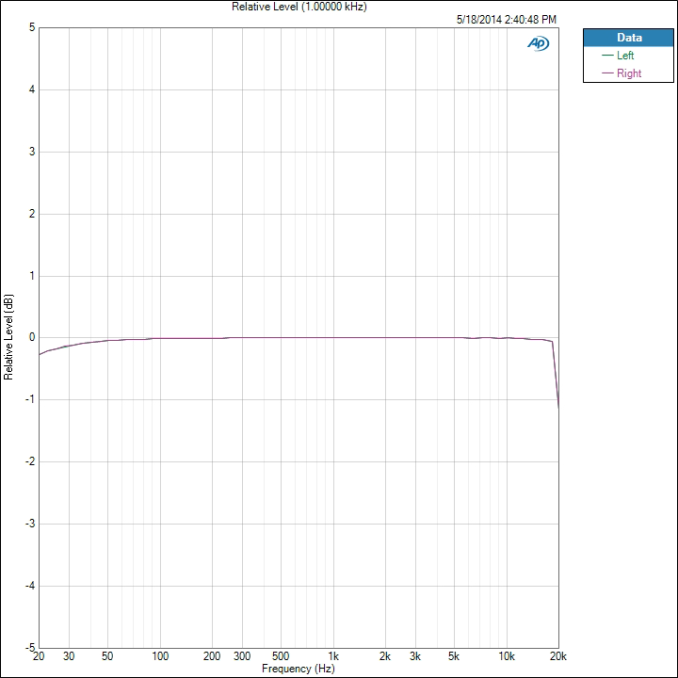
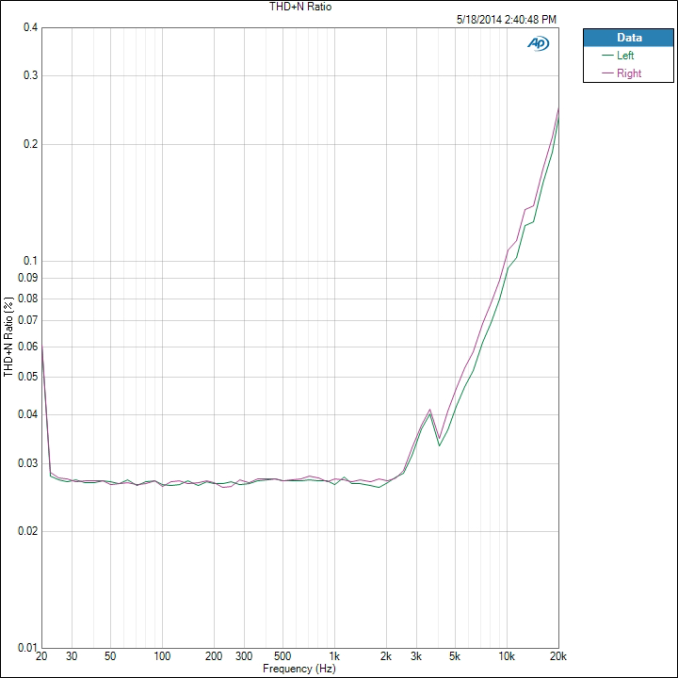
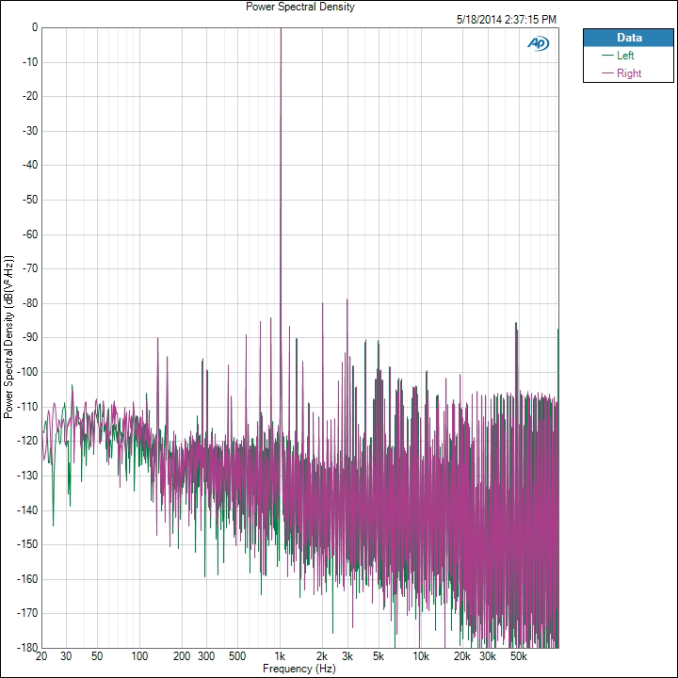
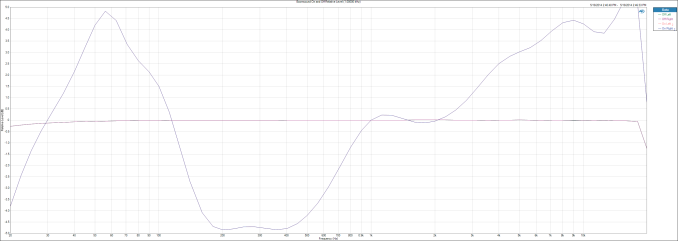
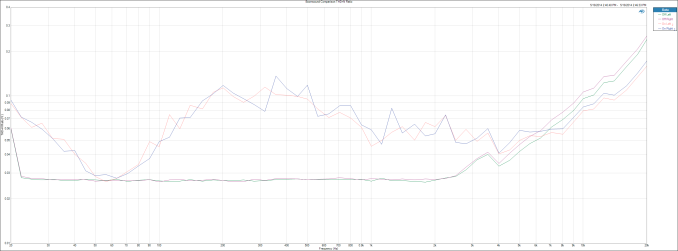








78 Comments
View All Comments
cheinonen - Wednesday, June 4, 2014 - link
It doesn't matter if they're using the same DAC. They provide no line-out functionality so you're subject to the limitations of the amplifier driving the headphone jack. In this case, the amplifier that HTC has chosen to use is far more powerful, with less noise and crosstalk, than the one that Samsung chose. It's impossible to isolate a single component, like the DAC, and expect everything that uses it to have identical performance. It's part of a system and everything else in the system has to perform at a level for it to function right.For the subjective testing, I'll leave that to Anand and Joshua who are spending far more hands-on time with the phones than I am. I'll run the numbers and provide a straight analysis of them.
theduckofdeath - Thursday, June 5, 2014 - link
The reason they need subjective listening is because they insist on using hyperbole to differentiate devices. Based on data output from a metering device.Here's an example why actual human testing is needed:
http://www.tomshardware.com/reviews/high-end-pc-au...
Lambasting something as horribly bad without actually making a real life comparison is a typical nerd error. "The numbers are superior, therefore it must sound superior!". The human ear is really limited in what sounds it can pick up. It's not nearly as accurate as Chris appears to think as very few adults, especially those who frequently listen to headphone music, can hear anything even near 20kHz.
synaesthetic - Saturday, June 7, 2014 - link
Sighted listening produces biased results. Measurements are verifiable, demonstrable and repeatable. Subjective listening tests are just that, subjective and thus useless to anyone but the person doing the listening.This is why I appreciate actual data. I can look at a frequency response graph for a headphone and compare it to another headphone I know I like, and I can get an idea how the other headphone sounds without having to decide which subjective listener's ears I'm going to trust.
theduckofdeath - Wednesday, June 11, 2014 - link
The point I made is, measuring things that are probably not even audible to a human being ,and use that as a review for audio quality is pretty pointless. Then you've really missed the whole point of being a product review site for devices intended for regular human use. :)apertotes - Tuesday, June 10, 2014 - link
but you did not answer. Which Galaxy S5 did you test?Jimster480 - Tuesday, June 10, 2014 - link
The M8 sounds alot better than the GS5. Its been determined so many different times. I own an M8 aswell and I have to say the sound quality is like none other.edzieba - Tuesday, June 3, 2014 - link
I'd like to see Output Impedance measurements. If that heads north of 2ohm, then that's a good red flag for things having gone seriously wrong.Rezurecta - Tuesday, June 3, 2014 - link
No it is not. Where did you get this misinformation?synaesthetic - Saturday, June 7, 2014 - link
Output impedance is THE single most important factor for how a given driver will sound with a given analog output. When the 1/8th Rule is violated, the driver will lose some or all of its electrical dampening. This usually tends to kill bass and warp the rest of the headphone's frequency response, making it sound abnormal.The fact that most manufacturers, reviewers and the like never bother to check output impedance is very, very annoying and makes headphone selection needlessly complicated. Very low-impedance headphones, such as Ultimate Ears IEMs, will not sound "normal" out of a source with an output impedance over 1.6 ohms.
Properly designed amplifier sections should have an output impedance as close to zero as possible so that they work properly with all headphones.
Jimster480 - Tuesday, June 10, 2014 - link
Well my M8 has worked fine with 5 different headphones I have tried it with. 3 Different sets of IEM's (Sony Earbuds, Skullcandy IEM's, and Bose IEM's). And a Sony over the ear aswell as a Panasonic RP-HT360 and it sounds very clear and rich on every set. No set is too loud nor does the sound reproduction sound incorrect or flawed.